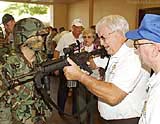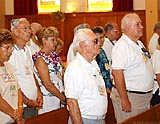
Back to Home
Back to News
A LEGENDARY BATTLE OF THE KOREAN WAR
The fighting withdrawal of the 1st Marine Division from the frigid Chosin Reservoir in North Korea from 27 November to 9 December 1950, is a legendary battle feat.


Ed Campbell, center, and Joe Clarkson, both of them retired sergeants first-class who belong to the 32nd Infantry Regiment Association, discuss the workings of the M4 carbine rifle with Pfc. Ronald Slauson at Schofield Barracks.
Veterans of the 32nd Inf. Rgt. and their spouses stand for the playing of taps during a memorial ceremony at the Main Post Chapel at Schofield Barracks.
Isolated and surrounded, the 1st Marine Division exacted a heavy toll on 10 Chinese infantry divisions during a fighting withdrawal to the east and the North Korean part of Hungnam. Less well known is the role played by "The Queen's Own" 32nd Infantry Regiment, a title bestowed by Queen Lili'uokalani in 1916 on the first infantry unit stood up in Hawai'i. "Task Force Faith," as the Army push later became known, fought a delaying action from 27 November to 1 December that kept several Chinese People's Volunteer Army divisions from outflanking the Marines, Army historians say.
Although it spent just two years on O'ahu before being transferred to Camp Kearny, Calif., in 1918, the regiment returned to its roots last week when the 32nd Infantry Association held a reunion in Hawai'i. Among the stops made by the 45 World War II and Korean War veterans was the U.S. Army Museum of Hawai'i at Fort DeRussy, where photos and drawings of Col. Don Carlos Faith Jr., a Medal of Honor recipient who died leading his troops at the Chosin Reservoir, were presented for a permanent display at the museum. When Faith was wounded by grenade shrapnel to the chest, Maj. Robert E. Jones organized the wounded and rallied remaining troops to fight on. For his actions, Jones would receive the Distinguished Service Cross.
The citation also is being added at the museum. Jones, 85, last week recalled temperatures of 40 degrees below zero, and being taken by surprise by overwhelming numbers of Chinese forces. The strategy had been to advance along the east bank of the Chosin Reservoir until the task force reached the border between North Korea and China. "We had elements of three Chinese divisions that came down the east side of the reservoir, and of course, the Marines were on the west side of the reservoir," Jones said. "We held off the Chinese on the east side for five days and made it possible for the Marines to consolidate and enable us to get out. Of course, we lost a lot of people." Col. Allan D. MacLean commanded two infantry battalions and one artillery battalion, as well as supporting fire units from the 31st and 32nd Infantry Regiments of the 7th Infantry Division. Serving occupation duty in Japan before the war, the division had little training, and lacked the heavy parkas and winter boots the Marines had.
When MacLean's forces came under fire, he thought U.S. troops were firing on their own men, and he ran out onto the ice. MacLean had made a deadly mistake, though, and the Chinese shot him four times before taking him prisoner. That left the command to Faith, who was able to unite the battalions, and start moving the wounded to the American lines at Hagaru-ri. Facing fire from Chinese on the high ground at a succession of roadblocks, Faith, .45-caliber automatic in hand, barked orders to his men to keep them moving as order disintegrated and some dropped their weapons and ran across the frozen reservoir, Army historians say. "I was in World War II, and I knew when things were going all right and when they weren't. It was a question of being overwhelmed and having wounded. We lost our officers, we lost our NCOs, we had intermingled units," said Jones, who retired as a colonel and now lives in Tennessee. "So by holding (the Chinese) off as long as we did, it gave the Marines time to form up. But we suffered for it when we tried to break out.
It was reduced to how many people you could control, how many people you could talk to." The units suffered an 80 percent casualty rate at Chosin Reservoir, 32nd Infantry Association members say. The regiment was stood up on O'ahu in 1916 with personnel from the 1st and 2nd Infantry Regiments. Army Museum curator Judy Bowman said the relationship between the U.S. Army and Queen Lili'uokalani was by then cordial. "From what we can tell, especially looking at the guest book o
f Washington Place, she entertained (Army officials) and they came to her home on a couple of different occasions," Bowman said. The commanding general of the Army made the queen an honorary member of the "Aero Club" as the airplane came into its own. The 32nd Infantry's unit crest still bears a Hawaiian war helmet. The crest originally included two crossed spears, or puela, but Bowman said at some point they were replaced with a Maltese cross. During World War I, regiment units escorted German prisoners being transferred to the United States from Hawai'i. The 32nd Infantry is now part of the 10th Mountain Division at Fort Drum in New York. Last week's reunion by the 32nd Infantry Association was the first to be held in Hawai'i.
The veterans laid a wreath at the National Memorial Cemetery of the Pacific Friday morning to commemorate the 50th anniversary of the Korean War. Retired Lt. Col. Andrew Dyckson, 71, said the U.S. Army's Central Identification Laboratory, Hawai'i, told the group 486 American service personnel are still missing in the Chosin Reservoir area. Among them may be Faith and MacLean, whose bodies were never found. "It took 50 years for people to realize that (Korea) wasn't a police action, it was a war," Dyckson said. "I think Congress did right by declaring it a war because we lost a lot of young bodies over there."
SPECIAL to WWW.HISTORICALMILITARIA.COM – 23 SEPTEMBER 2002
Back to Home
Back to News

Back to Home
Back to News
A LEGENDARY BATTLE OF THE KOREAN WAR
The fighting withdrawal of the 1st Marine Division from the frigid Chosin Reservoir in North Korea from 27 November to 9 December 1950, is a legendary battle feat.


Although it spent just two years on O'ahu before being transferred to Camp Kearny, Calif., in 1918, the regiment returned to its roots last week when the 32nd Infantry Association held a reunion in Hawai'i. Among the stops made by the 45 World War II and Korean War veterans was the U.S. Army Museum of Hawai'i at Fort DeRussy, where photos and drawings of Col. Don Carlos Faith Jr., a Medal of Honor recipient who died leading his troops at the Chosin Reservoir, were presented for a permanent display at the museum. When Faith was wounded by grenade shrapnel to the chest, Maj. Robert E. Jones organized the wounded and rallied remaining troops to fight on. For his actions, Jones would receive the Distinguished Service Cross.
The citation also is being added at the museum. Jones, 85, last week recalled temperatures of 40 degrees below zero, and being taken by surprise by overwhelming numbers of Chinese forces. The strategy had been to advance along the east bank of the Chosin Reservoir until the task force reached the border between North Korea and China. "We had elements of three Chinese divisions that came down the east side of the reservoir, and of course, the Marines were on the west side of the reservoir," Jones said. "We held off the Chinese on the east side for five days and made it possible for the Marines to consolidate and enable us to get out. Of course, we lost a lot of people." Col. Allan D. MacLean commanded two infantry battalions and one artillery battalion, as well as supporting fire units from the 31st and 32nd Infantry Regiments of the 7th Infantry Division. Serving occupation duty in Japan before the war, the division had little training, and lacked the heavy parkas and winter boots the Marines had.
When MacLean's forces came under fire, he thought U.S. troops were firing on their own men, and he ran out onto the ice. MacLean had made a deadly mistake, though, and the Chinese shot him four times before taking him prisoner. That left the command to Faith, who was able to unite the battalions, and start moving the wounded to the American lines at Hagaru-ri. Facing fire from Chinese on the high ground at a succession of roadblocks, Faith, .45-caliber automatic in hand, barked orders to his men to keep them moving as order disintegrated and some dropped their weapons and ran across the frozen reservoir, Army historians say. "I was in World War II, and I knew when things were going all right and when they weren't. It was a question of being overwhelmed and having wounded. We lost our officers, we lost our NCOs, we had intermingled units," said Jones, who retired as a colonel and now lives in Tennessee. "So by holding (the Chinese) off as long as we did, it gave the Marines time to form up. But we suffered for it when we tried to break out.
It was reduced to how many people you could control, how many people you could talk to." The units suffered an 80 percent casualty rate at Chosin Reservoir, 32nd Infantry Association members say. The regiment was stood up on O'ahu in 1916 with personnel from the 1st and 2nd Infantry Regiments. Army Museum curator Judy Bowman said the relationship between the U.S. Army and Queen Lili'uokalani was by then cordial. "From what we can tell, especially looking at the guest book o
f Washington Place, she entertained (Army officials) and they came to her home on a couple of different occasions," Bowman said. The commanding general of the Army made the queen an honorary member of the "Aero Club" as the airplane came into its own. The 32nd Infantry's unit crest still bears a Hawaiian war helmet. The crest originally included two crossed spears, or puela, but Bowman said at some point they were replaced with a Maltese cross. During World War I, regiment units escorted German prisoners being transferred to the United States from Hawai'i. The 32nd Infantry is now part of the 10th Mountain Division at Fort Drum in New York. Last week's reunion by the 32nd Infantry Association was the first to be held in Hawai'i.
The veterans laid a wreath at the National Memorial Cemetery of the Pacific Friday morning to commemorate the 50th anniversary of the Korean War. Retired Lt. Col. Andrew Dyckson, 71, said the U.S. Army's Central Identification Laboratory, Hawai'i, told the group 486 American service personnel are still missing in the Chosin Reservoir area. Among them may be Faith and MacLean, whose bodies were never found. "It took 50 years for people to realize that (Korea) wasn't a police action, it was a war," Dyckson said. "I think Congress did right by declaring it a war because we lost a lot of young bodies over there."
SPECIAL to WWW.HISTORICALMILITARIA.COM – 23 SEPTEMBER 2002